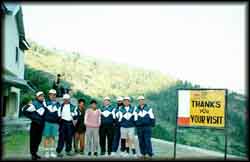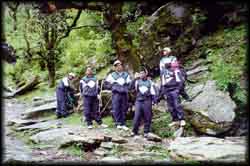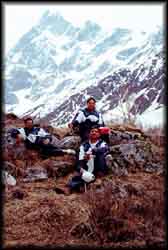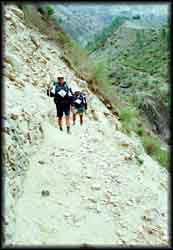| Trekking
Trek to Har-ki-Dun |
|||||
It all began in Nov'97, when it was decided to start a trekking club in our company ABB Ltd. A trekking coordinator was identified and given the task of coordinating a trek in the Himalayas in 1998. A number of treks, offering an abundance of Himalayan beauty, with its variable flora and fauna were identified and finally the choice was narrowed down to Har-ki-Dun, a popular trekking route in the Garhwal Himalayas at an altitude of 11,700 feet. Har stands for Lord Shiva and Doon implies valley, and Har-ki-Dun is therefore also called "Valley of the Gods". Har-ki-Dun is situated in the Western Garhwal, at the base of Fateh Parvat. This cradle shaped valley, South-east of Jaundiar glacier is surrounded by dense forests of pine, deodhar and other coniferous trees. It is totally covered by a blanket of blue and purple flowers. The surrounding forest is rich in wild life and exotic birds and forms part of the Govind wildlife Sanctuary and National Park, Uttarkashi. The main snow clad peaks visible from here are Swargarohini, Banderpunch and Kalanag. After selection of the trek, seven members confirmed their participation. Two weeks before the trek the team met and responsibilities were apportioned. Finally on 1st May'1998 at 10 pm the team assembled at Old Delhi station and boarded the Mussoorie Express for Dehradun with our ruck sacks and provisions, to start our journey to Sankri, the starting point of the trek. At 7:45 am the next day we steamed into Dehradun, and proceeded to the bus stand. As the direct bus to Sankri had left early in the morning, we took a bus to Vikas Nagar, 3 hrs away and from there, on to Purola. The trip to Purola took 6 hrs. |
More on Uttarakhand • An Overview
Trekking
Travelogues
Impressions
Adventure activities | ||||
From Mori we took a jeep and it took over an hour to reach Sankri at 8 pm, where we immediately took shelter in the Garhwal Mandal Vikas Nigam guest house atop a hillock, offering a fantastic view of the Himalayas. We had dinner at a local dhaba. We decided to start the trek from Taluka instead of Sankri, as the route till Taluka is now motorable and jeeps were plying there.
Next morning, the 3rd of May, we got up at 5 AM and were ready to leave by jeep at 6 am. At the local forest guest house, we booked the forest guest houses at Osla and Har-ki-Dun,, before taking the jeep to Taluka, an hour and a half's journey through a rocky path, dense forests and streams.
It was 8:30 am on 3rd May, when we started trekking to Osla, 16 km away, climbing from 7200 ft (Taluka) to 8500 ft (Osla). The trekking path runs parallel to the river Tons and its tributaries and for the first few kilometers we crossed several fields and small rivers. There were two villages along the way. Datmer, comprising of about 30-40 hutments found the entire population, including the children busy working in the fields. On the way, we crossed a large herd of sheep and mountain goats, who were being taken by their owners for grazing. In the hills, the wealth of individuals is generally judged by the number of sheep/goat he possesses. The local inhabitants take great pride in their animals, eagerly displaying them and fondly talking about them. The next village on our trek was Gangar. The village was high up on the slopes and there was a small dhaba, where we rested while snacking on biscuits and boiled eggs with tea. There was a stream nearby and all of us enjoyed the cool and refreshing water, refilling our water bottles. The short break had worked wonders in getting us up on out feet again. Another 3 hours of trekking and our rucksacks felt heavier by the step and our feet ached. After a strenuous journey of almost 2 hours, 2 pm found us at Seema, a village near Osla, where the forest guest house is located.
On 4th May, we started at 6 AM to proceed to our destination, Har-ki-Dun. All of us had a good nights sleep and were well charged. The distance from Seema to Har-ki-Dun is 14 kms, and a climb from 8,500 ft (Seema) to 11,700 ft (Har-ki-Dun). The path begins at a concrete bridge across the river Tons, after which there is a steep incline up for almost a kilometer. The path comprises loose rocks and pebbles and we had a tough time getting a firm foothold on the loose pebbles. After the steep climb, our path crisscrossed green wheat fields, meadows and several small streams. We halted frequently for resting, filling water and taking photographs on the way. We came across a point where the path was destroyed by a landslide. There, the path was barely a foot wide, with the sheer mountain face on one side and a steep drop of more than a thousand feet on the other side. The path was full of small rocks and loose soil, so it was difficult to maneuver. We managed to cross the path and after another haul of hiking, took a break for lunch near a small spring. We consumed our packed lunch, had some glucose for the additional surge of energy, and after an hours break loaded our rucksacks and started for the magnificent valley of the gods.
After preparing breakfast from the provisions we had brought, five of us decided to explore the nearby glaciers while the other two opted to enjoy the flowing river instead. The main glacier is about 9 kms from the guest house, covering an area of 12 sq. Kms. It took about 3 hrs to reach the glacier, walking along the beautiful valley covered with fresh lush green meadows spotted with bright flowers and small islands of frozen snow dotting the landscape. The last 4 kms was tougher with lots of rock climbing and several cascading streams to cross. With fresh white soft snow everywhere against the backdrop of a clear blue sky, it was a truly magical world out there that enchanted us with the surfeit of nature's boundless beauty. Our body aches and pains had vanished, and the sheer sense of achievement made us acutely aware that there are other aspects of life apart from the daily trivialities we are accustomed to remain immersed in. We came back to our guest house for a late lunch. We met up with a Czech medical student camping on the river bank on his own who regaled us with his vast experiences enroute from Czechoslavakia to India by road through China and Nepal.
At Sankri, we stayed at the same GMVN guest house. After dinner at the dhaba, we went to bed early. On 8th May morning, we woke early and caught the direct bus from Sankri to Dehradun, which departed at 5 AM. After an 11 hour journey we reached Dehradun and left for Delhi by the Shatabdi Express at 5 PM. On the train, while some of us caught up with the happenings in the country over the past 7 days when we had been lost to the world of news, others continued to savour their memories of the trail left behind in the magnificent Himalayas. Summary
Route Delhi - Dehradun - Vikas Nagar - Purola - Mori - Netawar - Sankri - Taluka - Seema (Osla) - Har-ki-Dun The best time for the trek is from May till August. A Nice and enjoyable trek, with plenty of fresh water all the way since the trek is along the Tons river course. Forest entry fee to be paid to UP forest department before reaching Sankri. Regarding accomodation, both Garwal Mandal Vikas Nigam Ltd., and the Forest Department have guest houses available at Sankri, Taluka, Seema and Har-ki-Dun, but the the Garwal Mandal Vikas Nigam has better toilet facilities, beds, pillows and rugs.
|
|||||
Editor: Romola Butalia (c) India Travelogue. All rights reserved. |
|||||
 At Purola we took another bus to Mori, the gateway to Sankri. The bus was jam-packed, so we elected to sit on the roof of the bus along with our belongings. The bus took us through a very picturesque route, lined with pine trees and deodars, the rocks covered with ferns, planktons and exotic flowers. The weather was cool and very comforting. All the days tiredness was gone as we sat there on top of the bus, assimilating the beauty of the mountains. Such was the magnificence of the surroundings that even when the bus became empty, all of us refused to come down, preferring to remain perched atop till the end of the journey.
At Purola we took another bus to Mori, the gateway to Sankri. The bus was jam-packed, so we elected to sit on the roof of the bus along with our belongings. The bus took us through a very picturesque route, lined with pine trees and deodars, the rocks covered with ferns, planktons and exotic flowers. The weather was cool and very comforting. All the days tiredness was gone as we sat there on top of the bus, assimilating the beauty of the mountains. Such was the magnificence of the surroundings that even when the bus became empty, all of us refused to come down, preferring to remain perched atop till the end of the journey.
 We took a short break for tea and breakfast at a local dhaba (tea house) at Taluka. Immediately afterwards we negotiated with a porter to carry our common belongings, help with cooking food and to guide us enroute. Feeding a hungry dog who was loitering nearby, we gained an additional member on our team, who wagged his way behind us for the next 5 days.
We took a short break for tea and breakfast at a local dhaba (tea house) at Taluka. Immediately afterwards we negotiated with a porter to carry our common belongings, help with cooking food and to guide us enroute. Feeding a hungry dog who was loitering nearby, we gained an additional member on our team, who wagged his way behind us for the next 5 days.
 On reaching the forest guest house, we met the caretaker who gave us a very warm welcome on learning that we had taken permission from the Ranger at Sankri for our stay. He provided us 3 bedrooms, with 2 beds each for the night. All the bedrooms had coirfoam mattresses and a fireplace as well. After a rest, we went to a nearby stream to have baths. The water was very chilly and acquainting our bodies with the first drops required sheer courage, but after that there was no looking back and we were completely refreshed to attack our lunch at the local dhaba. Recovering from the morning of hectic tramping, we made some 25 stuffed paranthas for the next day's brunch. Packed in aluminium foil along with pickle, they were distributed. Then we proceeded to make a basic dinner of rice and dal. Dinner was early at 7:30 pm as we had a tough trek ahead and wanted to retire to bed early. Without electricity, wanting to conserve our candles and torches, it was an easy choice.
On reaching the forest guest house, we met the caretaker who gave us a very warm welcome on learning that we had taken permission from the Ranger at Sankri for our stay. He provided us 3 bedrooms, with 2 beds each for the night. All the bedrooms had coirfoam mattresses and a fireplace as well. After a rest, we went to a nearby stream to have baths. The water was very chilly and acquainting our bodies with the first drops required sheer courage, but after that there was no looking back and we were completely refreshed to attack our lunch at the local dhaba. Recovering from the morning of hectic tramping, we made some 25 stuffed paranthas for the next day's brunch. Packed in aluminium foil along with pickle, they were distributed. Then we proceeded to make a basic dinner of rice and dal. Dinner was early at 7:30 pm as we had a tough trek ahead and wanted to retire to bed early. Without electricity, wanting to conserve our candles and torches, it was an easy choice.
 After manipulating a couple of tough climbs we could see the hint of one or two cottages just across a river. The sight of our destination recharged us and we walked briskly towards it. We reached Har-ki-Dun at around 1:30 PM. It was bright and sunny and we spent the next hour relishing the exotic environment. The forest rest house where we were to stay was surrounded by snow clad mountains, with fast moving milky clouds covering the peaks. Har-ki-dun was on a hillock between two streams with water swirling around and cascading speedily. The view was so enchanting and picturesque that we knew why indeed it is the valley of the gods. Sitting together over tea we decided that having come all the way to the valley, we had to stay another day and soak in the serenity of the place.
After manipulating a couple of tough climbs we could see the hint of one or two cottages just across a river. The sight of our destination recharged us and we walked briskly towards it. We reached Har-ki-Dun at around 1:30 PM. It was bright and sunny and we spent the next hour relishing the exotic environment. The forest rest house where we were to stay was surrounded by snow clad mountains, with fast moving milky clouds covering the peaks. Har-ki-dun was on a hillock between two streams with water swirling around and cascading speedily. The view was so enchanting and picturesque that we knew why indeed it is the valley of the gods. Sitting together over tea we decided that having come all the way to the valley, we had to stay another day and soak in the serenity of the place.
 At 6 am the next morning, we began the return journey, mostly downhill and easy to negotiate. We reached Osla at 11:30 am where it started raining as we reached the forest guest house. It continued to rain right through the day and into the next. Depressed by the rain, we despondently watched it pouring. Finally, when it relented at 9:30 am we eagerly set off with our backpacks secured. It took us over 4 hrs to reach Taluka, from where we proceeded to Sankri at 4 pm. After an hour and a half of walking, we came to a point where a stream overflowed across the road because of the heavy rainfall. The current was strong and the water was at least two feet deep. While seeking a safe way to cross the stream a local Gujjar, or shepherd, crossed the stream to our side, giving us the confidence to proceed on.
At 6 am the next morning, we began the return journey, mostly downhill and easy to negotiate. We reached Osla at 11:30 am where it started raining as we reached the forest guest house. It continued to rain right through the day and into the next. Depressed by the rain, we despondently watched it pouring. Finally, when it relented at 9:30 am we eagerly set off with our backpacks secured. It took us over 4 hrs to reach Taluka, from where we proceeded to Sankri at 4 pm. After an hour and a half of walking, we came to a point where a stream overflowed across the road because of the heavy rainfall. The current was strong and the water was at least two feet deep. While seeking a safe way to cross the stream a local Gujjar, or shepherd, crossed the stream to our side, giving us the confidence to proceed on.